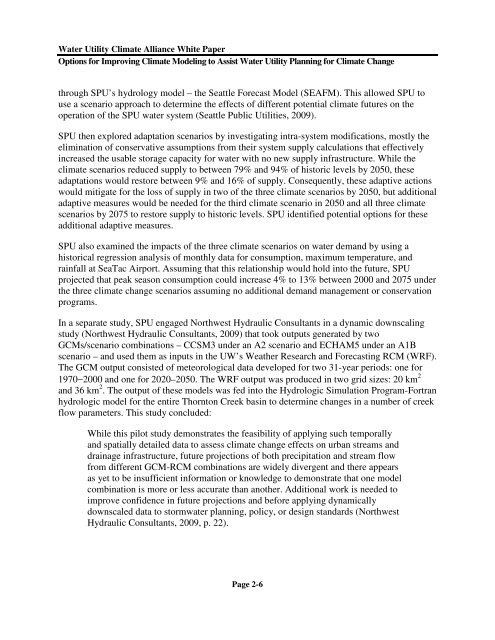Options for Improving Climate Modeling to Assist Water Utility ...
Options for Improving Climate Modeling to Assist Water Utility ...
Options for Improving Climate Modeling to Assist Water Utility ...
Create successful ePaper yourself
Turn your PDF publications into a flip-book with our unique Google optimized e-Paper software.
<strong>Water</strong> <strong>Utility</strong> <strong>Climate</strong> Alliance White Paper<br />
<strong>Options</strong> <strong>for</strong> <strong>Improving</strong> <strong>Climate</strong> <strong>Modeling</strong> <strong>to</strong> <strong>Assist</strong> <strong>Water</strong> <strong>Utility</strong> Planning <strong>for</strong> <strong>Climate</strong> Change<br />
through SPU’s hydrology model – the Seattle Forecast Model (SEAFM). This allowed SPU <strong>to</strong><br />
use a scenario approach <strong>to</strong> determine the effects of different potential climate futures on the<br />
operation of the SPU water system (Seattle Public Utilities, 2009).<br />
SPU then explored adaptation scenarios by investigating intra-system modifications, mostly the<br />
elimination of conservative assumptions from their system supply calculations that effectively<br />
increased the usable s<strong>to</strong>rage capacity <strong>for</strong> water with no new supply infrastructure. While the<br />
climate scenarios reduced supply <strong>to</strong> between 79% and 94% of his<strong>to</strong>ric levels by 2050, these<br />
adaptations would res<strong>to</strong>re between 9% and 16% of supply. Consequently, these adaptive actions<br />
would mitigate <strong>for</strong> the loss of supply in two of the three climate scenarios by 2050, but additional<br />
adaptive measures would be needed <strong>for</strong> the third climate scenario in 2050 and all three climate<br />
scenarios by 2075 <strong>to</strong> res<strong>to</strong>re supply <strong>to</strong> his<strong>to</strong>ric levels. SPU identified potential options <strong>for</strong> these<br />
additional adaptive measures.<br />
SPU also examined the impacts of the three climate scenarios on water demand by using a<br />
his<strong>to</strong>rical regression analysis of monthly data <strong>for</strong> consumption, maximum temperature, and<br />
rainfall at SeaTac Airport. Assuming that this relationship would hold in<strong>to</strong> the future, SPU<br />
projected that peak season consumption could increase 4% <strong>to</strong> 13% between 2000 and 2075 under<br />
the three climate change scenarios assuming no additional demand management or conservation<br />
programs.<br />
In a separate study, SPU engaged Northwest Hydraulic Consultants in a dynamic downscaling<br />
study (Northwest Hydraulic Consultants, 2009) that <strong>to</strong>ok outputs generated by two<br />
GCMs/scenario combinations – CCSM3 under an A2 scenario and ECHAM5 under an A1B<br />
scenario – and used them as inputs in the UW’s Weather Research and Forecasting RCM (WRF).<br />
The GCM output consisted of meteorological data developed <strong>for</strong> two 31-year periods: one <strong>for</strong><br />
1970−2000 and one <strong>for</strong> 2020–2050. The WRF output was produced in two grid sizes: 20 km 2<br />
and 36 km 2 . The output of these models was fed in<strong>to</strong> the Hydrologic Simulation Program-Fortran<br />
hydrologic model <strong>for</strong> the entire Thorn<strong>to</strong>n Creek basin <strong>to</strong> determine changes in a number of creek<br />
flow parameters. This study concluded:<br />
While this pilot study demonstrates the feasibility of applying such temporally<br />
and spatially detailed data <strong>to</strong> assess climate change effects on urban streams and<br />
drainage infrastructure, future projections of both precipitation and stream flow<br />
from different GCM-RCM combinations are widely divergent and there appears<br />
as yet <strong>to</strong> be insufficient in<strong>for</strong>mation or knowledge <strong>to</strong> demonstrate that one model<br />
combination is more or less accurate than another. Additional work is needed <strong>to</strong><br />
improve confidence in future projections and be<strong>for</strong>e applying dynamically<br />
downscaled data <strong>to</strong> s<strong>to</strong>rmwater planning, policy, or design standards (Northwest<br />
Hydraulic Consultants, 2009, p. 22).<br />
Page 2-6

















